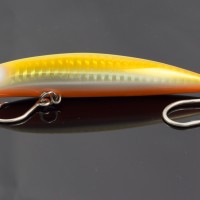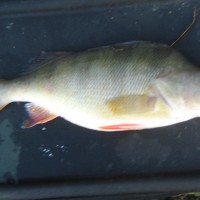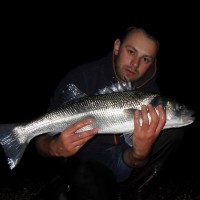What is the best colour lure for Bass fishing, or does it even matter? I recently read an article written by Steve Starling, which I have had permission to include in this post. I will let you read it, then you can read my observations at the end of it.
Most keen anglers have a favorite lure or fly color, and swear that their choice will out-perform all other offerings. But just how important is color when it comes to lure and fly selection? Well, according to science, not very important at all!
Water progressively absorbs or blocks light of different wavelengths, meaning that colors effectively “vanish” one after another as “white” sunlight travels through the water column. The overall intensity or brightness of visible light also diminishes rapidly underwater.
Because this absorption is greater for longer wavelengths (the red end of the spectrum) than for shorter wavelengths (the blue end of the spectrum), perceived colors are rapidly altered with increasing depth or distance through the water.
The precise rate at which this loss of color occurs varies depending on the intensity of the sunlight, whether the sun is directly overhead or low on the horizon, the amount of cloud cover, as well as the clarity and color of the water itself, and the presence of any suspended matter such as weed or plankton. Even in very clear ocean currents far from shore, less than 25 percent of available sunlight hitting the sea’s surface will penetrate much beyond 30 feet or so. By the time we reach a depth of 300 feet, the remaining light may be as little as 0.5 percent of that available on the surface. In other words, it’s a pretty gloomy place down there! In freshwater lakes and rivers, this loss of light with depth is even more dramatic.
As already mentioned, red is the first color visible to our eyes to disappear, and is typically gone within 15 or 20 feet of the surface. much less in turbid water. Orange disappears next, then yellow, green, and purple. Blues penetrate deepest of all, both the tones visible to our human eyes and also the shorter, ultra-violet wavelength many fish can see.
This phenomenon has a profound impact on the way things look to us, and also to fish underwater. White objects will appear bluish or gray underwater, and the darkness of that blue/gray appearance increases rapidly with depth. Red objects will begin to look dark brown or even black within a few meters of the surface. Down at 40 or 50 feet, even in very clear water, the world appears to be composed entirely of shades of gray, blue, and black.
It’s worth stressing that this loss or alteration of visible colors occurs in both the vertical and the horizontal or diagonal planes. So, 40 feet of vertical depth has roughly the same impact on light waves and color perception as 40 feet of horizontal or diagonal separation between object and observer. In other words, a red lure may look black when viewed at a depth of 40 feet, but it will also appear black, or at the least brown or very dark grey, when viewed from the side at a distance of 40 feet, even if it’s traveling right up in the surface layer.
At face value, this phenomenon of light and color loss underwater makes a mockery of the importance of color in lures anywhere beyond shallow, ultra-clear scenarios, yet anglers the world over will continue to argue that one color is better than another, even in deep-water jigging. The funny thing is, if you ask half a dozen fishers for their opinion on the most effective lure color, you’re likely to receive six different answers. Perhaps it’s time we moved color to the bottom of the list of criteria when choosing a lure or fly, and placed far greater emphasis on the size, action, profile, and speed of our offerings.
I am sure you will agree that Steve’s article is well written and contains some interesting points. However I don’t agree with all that Steve says.
Firstly these observations as to the changes in colour at different depths, are based on those of the human eye and brain. I don’t care how clever the scientists are they do not truly know how a fish views colour. Like us they have evolved over the millennia, and they may even have a better perception of colour than we do. On the other hand they may just see them as different shades, it is unlikely we will ever know.
One thing that I do know is that the colour of the lure can at times be the most important choice you can make. I do stress that I say at times, because there are plenty of occasions when you could throw any lure colour, or shape in the water and catch. In my “A box” of lures that I use most of the time, there are normally only 4 or 5 different styles of lure, but I will often carry 3 different colours of that one lure.
When fishing for Wrasse, they can be incredibly picky about colour. My observations are that colour is more important than lure style when fishing for them. I hope to prove this much more comprehensively this year, when I use a system that I can make small changes to the colour of the lures ,that I believe will have a huge impact on my catch rate.
I know from my time commercial fishing for Bass how critical colour can be when fishing with lures as deep as 30m. In a boat with four fishermen, we would normally start off on different colours and different lure styles. Normally Sidewinders and Shads. If one fisherman is out fishing the others for no particular reason then we would change to that pattern and colour. I have known it, where even the different shade of white on a Sidewinder can make the difference between catching one fish a drift, to only catching a fish every third or fourth drift.

So the next time you are out fishing with lures, and you are struggling then think about changing colour.














An interesting article but it probably only scratches the surface. I believe that some scientific studies have been done to detect (commercially valuable) fishes reactions to colour under controlled conditions. I think that Mike Ladle refers to this in one of his ‘Operation Sea Angler’ books. If memory serves me correctly I think that chartreuse produced a strong reaction indicating that fish were sensitive to it. Of course this does not necessarily imply that they would want to eat it. I know that some scientific work has been done on how various mammals differentiate colour; rabbits can see colours better at the short end of the spectrum. This gives them better vision in low light conditions and allows them to distinguish more shades of green than humans. Very useful for a partly nocurnal grazer. On the other had they do not see red foxes anything like as clearly as we do which goes some way towards explaining how foxes can catch so many. Presumably the evolutionary advantage of good low light feeding outweighs the increased risk of predation. The ratio of rods to cones in rabit eyes is also different to ours giving better black and white perception of movement in low light. As mammals colour perception varies to suit habitat it seems likely that fish colour perception will also vary according to natural environment. There is little advantage to deep sea species in being able to distinguish red from black if red looks black at depth. There is considerable advantage to being able to see very short wavelengths possibly shorter than we can see.
Another factor not mentioned is that many objects will appear as a black silhouette when seen from below. ie. they will appear black regardless of colour. Surface dwelling prey fish have evolved highly reflective undersides to reduce this effect and make themselves less visible.
So what hypotheses can we develop from these observations?
My current thinking would be along these lines:
When fishing a lure above a fish a dark colour will be most conspicuous and silver/white most natural. Possibly size, shape and action will matter more than colour.
If chartreuse really is so visible fish above or level with the lure may be able to see it clearly, possibly a colour to try when bouncong a weedless soft plastic along the bottom for wrasse.
The deeper you fish the fewer colours can be seen so colour choice is probably less important; bellow 100 feet deep ‘firetails’ probably look black particularly to pollack with their upward facing eyes.
Further thoughts include the fact that confidence in your lures plays a big part in success; if you believe that you have the best lure you will use it a lot and fish it well. Surprise, surprise this is the lure that will catch fish thus making sure that you use it even more.
If you are fishing shallow water it is also helpful if you can see you lure so that you can fish it near snags etc. A silver/pearl lure looks realistic from below and can be seen by the angler above thus giving two reasons to use it in shallow snag filled water.
Finally lure manufacturers make lures primarily to catch anglers
A really good article, great insight.
So what are readers favourite colours or lures? Out of the thousands of readers I am sure that some have some views.